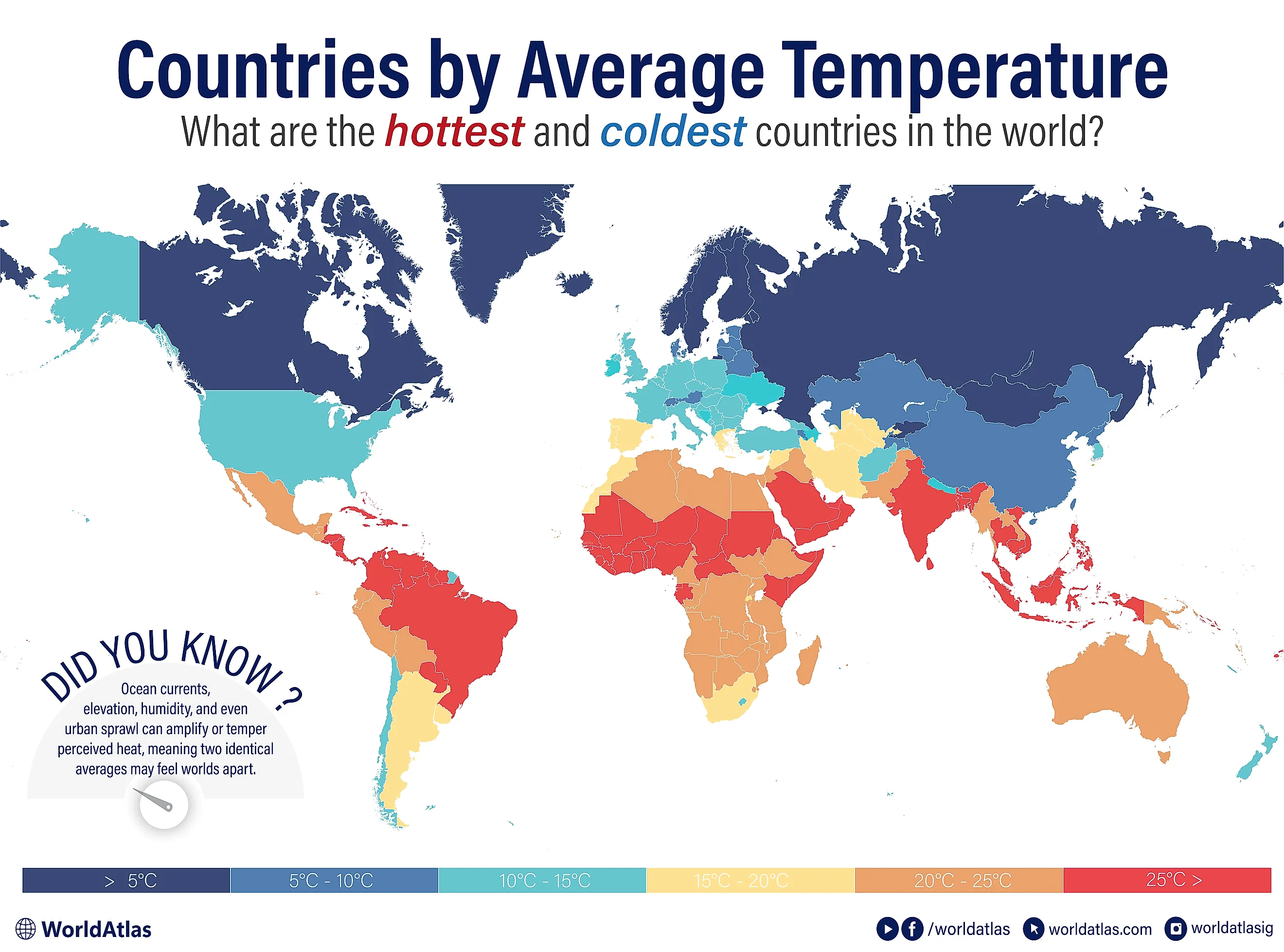
The 10 Hottest Countries In The World 2025
Our planet's true "hot spots" span dusty Sahel hinterlands, glimmering Gulf city-states, and turquoise-ringed Caribbean isles. Drawing average land-surface temperatures compiled by Trading Economics, our ranking reveals where thermometers refuse to drop below a sweltering 28 °C. West Africa dominates: Burkina Faso now leads at 29.96 °C, trailed closely by Mali (29.72 °C) and Senegal (29.69 °C), a fiery trio forged by low latitudes, cloud-clearing Harmattan winds, and scarce high terrain.
But latitude alone doesn't tell the whole story. Tiny Aruba and the Cayman Islands, bathed in year-round trade-wind sun, crack the top ten, proving that perpetual heat can coexist with postcard beaches. Meanwhile, Gulf monarchies such as Qatar and the United Arab Emirates turn their desert margins into megacity ovens; summer asphalt there regularly outbakes surrounding dunes.
Ocean currents, elevation, humidity, and even urban sprawl can amplify or temper perceived heat, meaning two identical averages may feel worlds apart. The article ahead examines the ten hottest countries, unpacking the geography, climate mechanics, and human adaptations that keep life humming where shade is never optional daily.
The 10 Hottest Countries In The World
| Rank | Country | Average Yearly Temperature (°C) |
|---|---|---|
| 1 | Burkina Faso | 29.96 |
| 2 | Mali | 29.72 |
| 3 | Senegal | 29.69 |
| - | Aruba* | 29.39 |
| 4 | Mauritania | 29.37 |
| 5 | Gambia | 29.16 |
| 6 | Qatar | 29.07 |
| 7 | United Arab Emirates | 28.95 |
| 8 | Bahrain | 28.88 |
| 9 | Guinea Bissau | 28.7 |
| - | Cayman Islands* | 28.64 |
| 10 | Benin | 28.61 |
*Aruba is a dependency of the Netherlands. The Cayman Islands are a dependency of the UK.
Jump to a list of all countries ranked by average yearly temperature
1. Burkina Faso - 29.96 °C
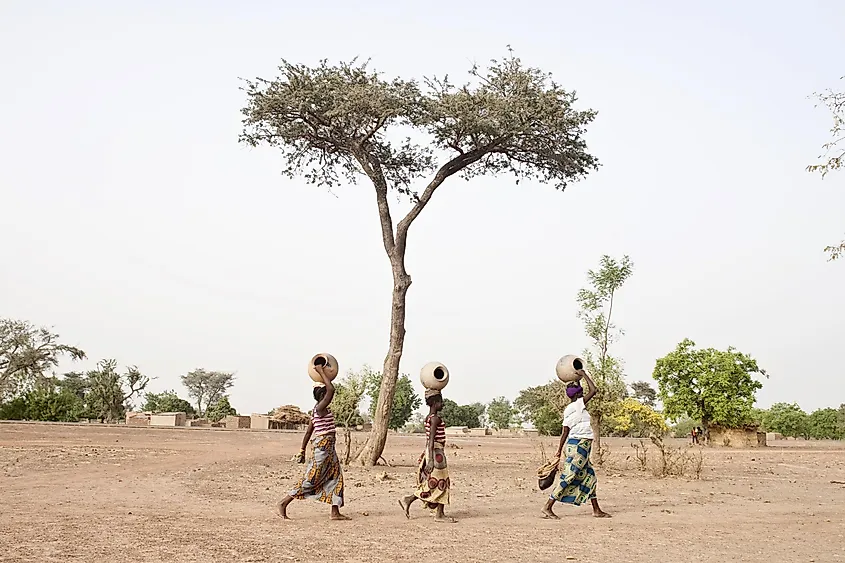
Burkina Faso, a landlocked Sahel nation straddling the 12 °N latitude, tops global heat charts with a 2023 mean land-surface temperature of 29.96 °C. Its low-lying peneplain (average altitude 400 m) and sparse tree cover invite the harmattan's parching breath nine months a year, while a brief June-September wet season delivers barely 600 mm of rain in northern provinces. Heat amplifies food-security challenges and drives mass rural-to-urban migration toward Ouagadougou. Yet gold-rich Burkina Faso adapts: solar megaprojects at Zagtouli supply power, and shade-walled Sahelian architecture tempers interior spaces. Life, culture, and livestock here spin around daylong quests for water and whispered hopes of cloud.
2. Mali - 29.72 °C
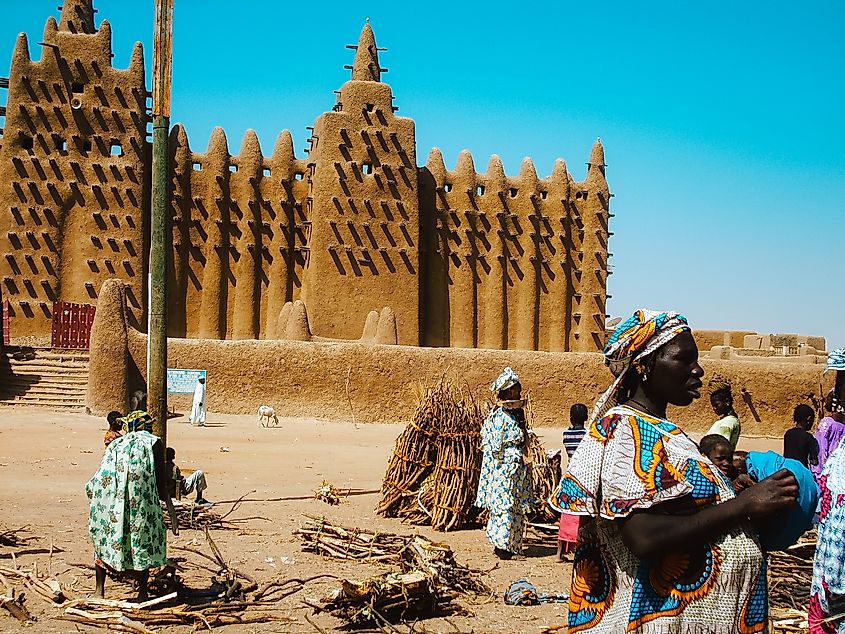
Straddling the thermal equator, land-locked Mali endures some of Earth's most relentless heat. Two-thirds of its 1.24-million km2 sprawl lies within the Sahara, while the rest broils on the semi-arid Sahel and Sudanian savanna. Average daytime highs above 40 °C dominate eight months a year; in Timbuktu and Gao, land-surface readings top 46 °C at the pre-monsoon peak. Rain is fleeting, barely 100 mm in the north and 500 mm farther south, leaving dust-laden harmattan winds, recurrent drought, and sandstorm temperatures that scorch crops and pasture. Communities adapt with flood-recession farming along the Niger, earthen-vault architecture and rapidly expanding solar-powered water points for villages and livestock.
3. Senegal - 29.69 °C
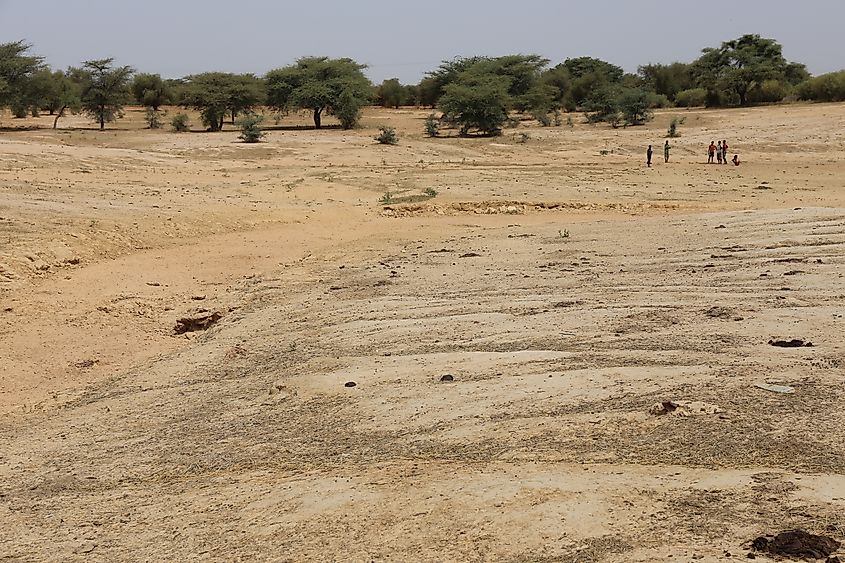
Stretching from the Atlantic coast to the fringes of the Sahara, Senegal spends much of the year under intense Sahelian sun. Along the interior plains, especially around Tambacounda and Matam, pre-monsoon afternoons frequently exceed 45 °C, and the mercury has reportedly spiked to 54 °C in searing harmattan seasons. Rain falls briefly between June and September, but most of the country bakes in a prolonged dry season driven by hot, dusty northeasterlies. Coastal Dakar enjoys ocean moderation, yet land-surface temperatures still soar across the Cap-Vert peninsula. Drought-tolerant millet farming, baobab groves, and community windbreak projects help residents cope with relentless heat year-round.
4. Mauritania - 29.37 °C
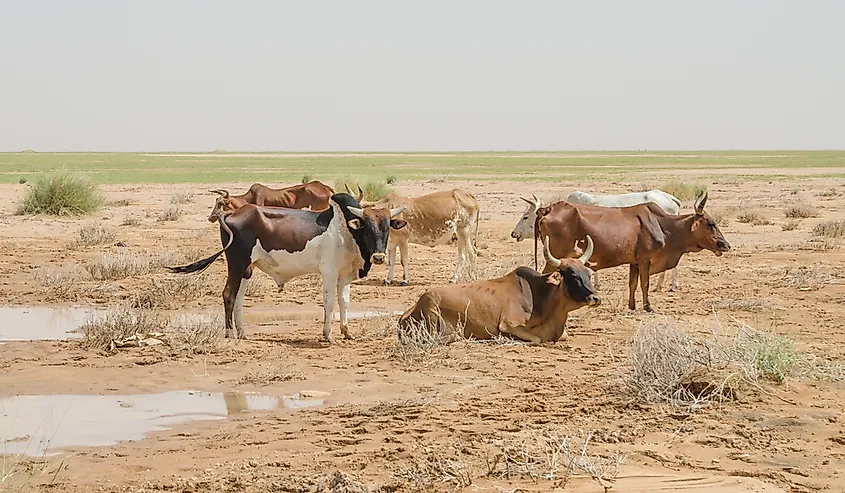
Mauritania, straddling the Sahel and Maghreb, is almost entirely desert, with 90% of its 1,030,000 km2 baked by the Sahara's scorching sun. Temperatures routinely surpass 45 °C on the vast sand seas of El Djouf and the Adrar plateau, while rain is scarce and unpredictable, confining most life to southern oases and the Senegal River strip. Harmattan winds whip dust across the plateaus, amplifying heat and driving relentless desertification northward and southward alike. Sparse vegetation, migrating dunes, and drought-ridden decades have pushed nomads to coastal Nouakchott, where even Atlantic breezes offer limited relief from Mauritania's searing, year-round furnace for inhabitants and livestock.
5. Gambia - 29.16 °C
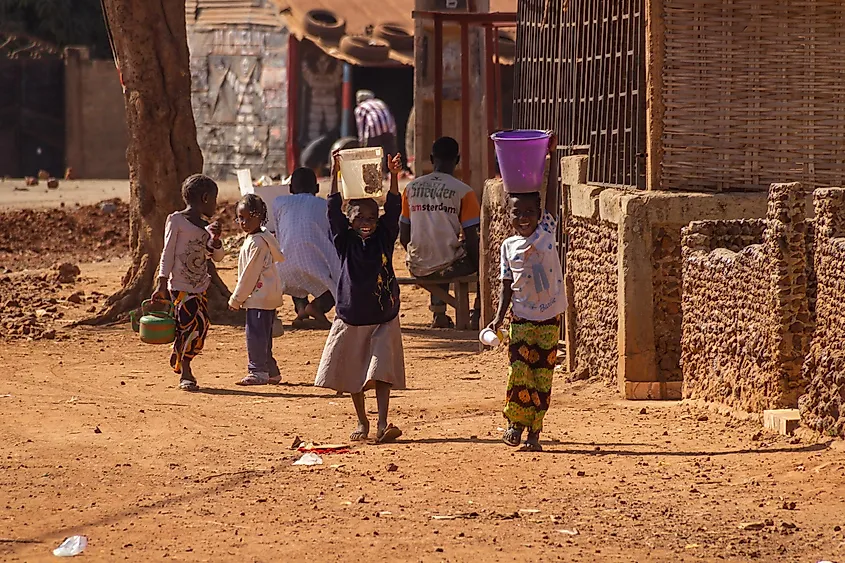
The Gambia, a narrow West African ribbon flanking the lower Gambia River, bakes under a tropical savannah climate that keeps thermometers hovering above 30 °C most of the year. March-May bring the fiercest heat, with inland highs regularly topping 40 °C before relief arrives from short June-September rains. Humidity soars to 80% in the wet season, turning coastal Banjul and the densely populated Serrekunda into steamy cauldrons, while dusty Harmattan winds intensify dryness upriver. With fewer than 50 km separating north and south banks, the entire 11,300 km2 nation feels the sun's glare, making agriculture, wildlife and everyday life hostage to relentless heat all year-round.
6. Qatar - 29.07 °C
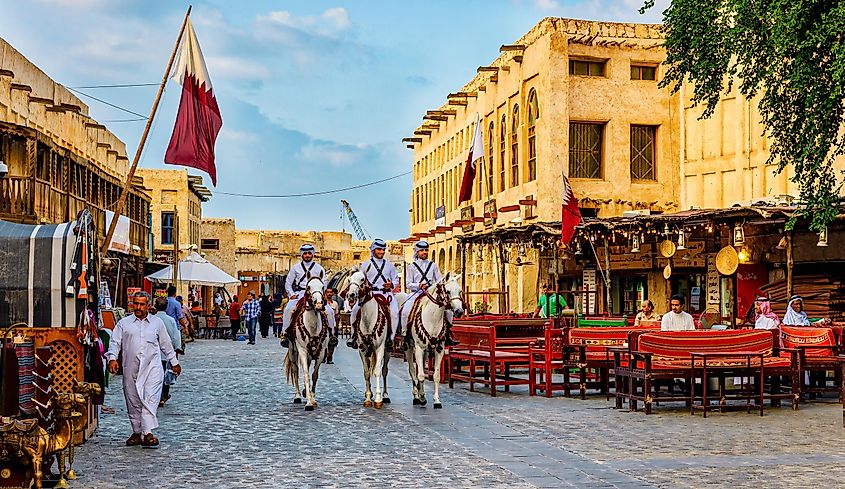
Qatar, a low-lying desert peninsula jutting into the Persian Gulf, ranks among the planet's furnace states. Summers scorch with average daytime highs of 42 °C and peaks topping 50 °C; winter afternoons still hover around 22-25 °C. Annual rainfall barely reaches 70 mm, leaving most of the 11,581 km2 territory parched and sand-covered. Clear skies, intense solar radiation, and warm Gulf waters push sea-surface temperatures above 33 °C in August, generating oppressive heat indices. With virtually no topographic relief and rapid urbanisation around Doha, the urban-heat-island effect magnifies the swelter. Qatar's oil-rich economy also drives the world's highest per-capita CO2 output, underscoring its extreme climate profile status.
7. United Arab Emirates - 28.95 °C
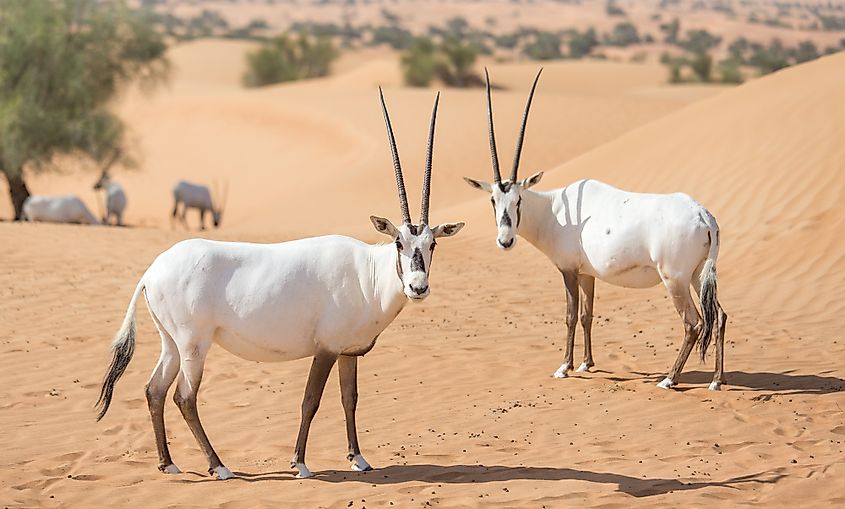
Scorching sun defines this desert federation on the southeastern Arabian Peninsula, the UAE. Summers are brutal: July-August coastal highs routinely exceed 45 °C, while inland dunes creep toward 50 °C under cloud-free skies. Humid Sharqi winds turn Dubai and Abu Dhabi into saunas, yet annual rainfall stays below 120 mm, leaving vast salt pans and the Empty Quarter's rolling sands parched. Occasional dust storms strip visibility; winter nights drop only to 10-14 °C. Residents counter extremes with air-conditioned megacities, shaded souks, and world-class infrastructure, scheduling outdoor life for cooler dawns and evenings. Despite the heat, tourism, trade, and oil wealth continue to thrive.
8. Bahrain - 28.88 °C

Bahrain, a small island kingdom in the Persian Gulf, routinely ranks among the planet's hottest inhabited places. Summer temperatures soar above 40 °C, amplified by very high humidity that rises from the shallow surrounding seas. Situated at 26 °N, the flat desert archipelago receives scant annual rainfall, about 70 mm, and endures shamal dust storms driven by winds sweeping off the Arabian Peninsula. Climate change is intensifying extreme heat, drought and flooding, while sea-level rise threatens its low-lying coastline. Despite ambitious net-zero targets, Bahrain remains one of the world's highest per-capita greenhouse-gas emitters, heavily dependent on fossil-fuel energy. Public health officials issue heat advisories.
9. Guinea Bissau - 28.7 °C
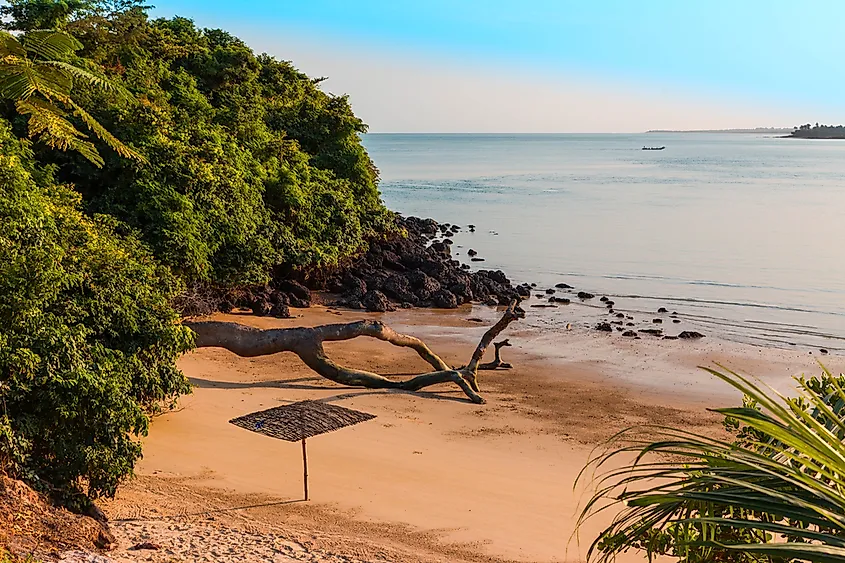
At roughly 12 °N on Africa's Atlantic rim, Guinea-Bissau ranks among the planet's sultriest places. Mean temperatures sit near 26 °C all year, surging beyond 35 °C in the pre-monsoon months. June-October rains add stifling humidity, often above 90%, that keeps nights uncomfortably warm. The dry December-April harmattan season brings Sahara dust and solar glare, yet daytime readings still often hover around 30 °C and higher. Low, swampy terrain lined with mangroves traps heat, while warming seas amplify oppressive dew points along the Bijagós Archipelago. Climate change is intensifying extremes, raising drought, flood, and mosquito-borne disease risks for the rural population.
10. Benin - 28.61 °C
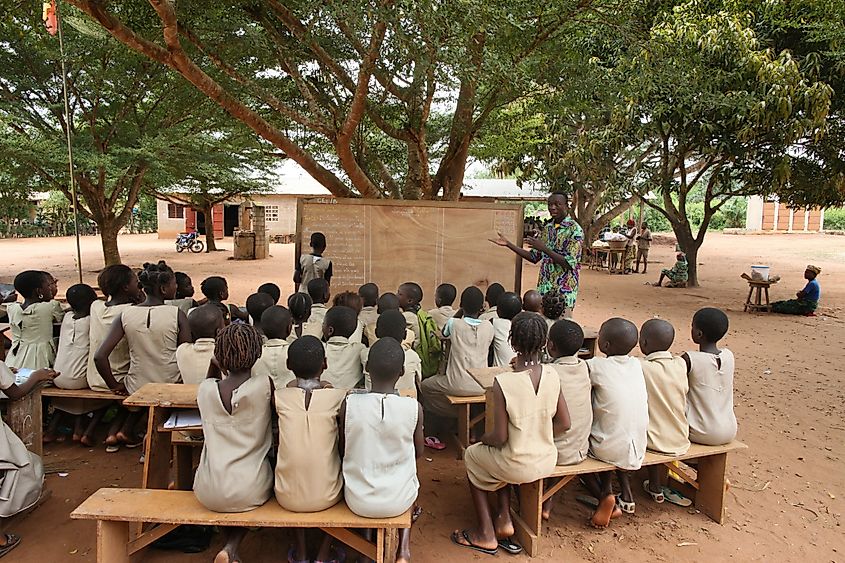
Benin, wedged between Togo and Nigeria on the sultry Bight of Benin, bakes under an equatorial sun for most of the year. Coastal Cotonou averages 31 °C by day and rarely dips below 24 °C at night, while interior savanna towns regularly top 40 °C during the March-May pre-rainy season. Two brief rainy breaks (April-July, September-November) trade scorching skies for brooding humidity, keeping heat indices oppressive. From December to March, the Saharan harmattan wind merely adds dusty glare, not relief, as drought and water scarcity intensify. Rising temperatures and sea-level threat now compound health, agriculture, and energy stresses nationwide throughout the vulnerable economy.
Average Yearly Temperature By Country
| Rank | Country/Region | Average Yearly Temperature (°C) |
|---|---|---|
| 1 | Burkina Faso | 29.96 |
| 2 | Mali | 29.72 |
| 3 | Senegal | 29.69 |
| - | Aruba* | 29.39 |
| 4 | Mauritania | 29.37 |
| 5 | Gambia | 29.16 |
| 6 | Qatar | 29.07 |
| 7 | United Arab Emirates | 28.95 |
| 8 | Bahrain | 28.88 |
| 9 | Guinea Bissau | 28.7 |
| - | Cayman Islands* | 28.64 |
| 10 | Benin | 28.61 |
| 11 | Djibouti | 28.6 |
| 12 | Niger | 28.34 |
| 13 | Marshall Islands | 28.29 |
| 14 | Ghana | 28.26 |
| 15 | Oman | 28.23 |
| 16 | Maldives | 28.18 |
| 17 | St Kitts and Nevis | 28.14 |
| 18 | Singapore | 28.1 |
| 19 | Cambodia | 27.95 |
| 20 | Togo | 27.92 |
| 21 | Antigua and Barbuda | 27.83 |
| 22 | Sudan | 27.8 |
| 23 | Kiribati | 27.78 |
| 24 | Nigeria | 27.73 |
| 25 | Samoa | 27.72 |
| 26 | Micronesia | 27.68 |
| - | Guam* | 27.67 |
| 27 | Seychelles | 27.58 |
| - | Virgin Islands* | 27.54 |
| 28 | Kuwait | 27.52 |
| 29 | Thailand | 27.51 |
| - | American Samoa* | 27.5 |
| 30 | Chad | 27.49 |
| 31 | St Lucia | 27.46 |
| 32 | Sri Lanka | 27.41 |
| - | Northern Mariana Islands* | 27.35 |
| 33 | Dominica | 27.32 |
| 34 | Ivory Coast | 27.3 |
| 35 | Palau | 27.26 |
| 36 | Sierra Leone | 27.22 |
| 37 | Trinidad and Tobago | 27.15 |
| 38 | Suriname | 27.13 |
| 39 | Somalia | 27.1 |
| 40 | Barbados | 26.93 |
| 41 | Philippines | 26.91 |
| 42 | Eritrea | 26.88 |
| 43 | Grenada | 26.78 |
| 44 | Malaysia | 26.77 |
| 45 | Cuba | 26.7 |
| 46 | Guyana | 26.67 |
| 47 | Jamaica | 26.65 |
| 48 | St Vincent and the Grenadines | 26.64 |
| 49 | Guinea | 26.6 |
| 50 | Bahamas | 26.56 |
| 51 | Saudi Arabia | 26.52 |
| 52 | Nicaragua | 26.51 |
| 53 | Belize | 26.42 |
| 54 | Indonesia | 26.17 |
| 55 | Panama | 26.05 |
| 56 | Venezuela | 26.01 |
| 57 | Bangladesh | 26 |
| 58 | Yemen | 25.93 |
| 59 | Brazil | 25.92 |
| 60 | Solomon Islands | 25.89 |
| 61 | Liberia | 25.87 |
| 62 | El Salvador | 25.85 |
| 63 | Haiti | 25.59 |
| 64 | Kenya | 25.54 |
| - | Puerto Rico* | 25.52 |
| - | Mayotte* | 25.5 |
| 65 | Vietnam | 25.46 |
| 66 | Costa Rica | 25.42 |
| 67 | Central African Republic | 25.39 |
| 68 | Honduras | 25.39 |
| 69 | Colombia | 25.32 |
| 70 | Dominican Republic | 25.23 |
| 71 | Fiji | 25.2 |
| 72 | Gabon | 25.14 |
| 73 | Tonga | 25.12 |
| 74 | Paraguay | 25.06 |
| 75 | India | 25.02 |
| 76 | Cameroon | 24.99 |
| 77 | Laos | 24.91 |
| 78 | Mozambique | 24.79 |
| 79 | Papua New Guinea | 24.77 |
| 80 | Republic of the Congo | 24.77 |
| - | French Polynesia* | 24.71 |
| 81 | Equatorial Guinea | 24.7 |
| 82 | Sao Tome and Principe | 24.66 |
| 83 | Myanmar | 24.44 |
| 84 | Vanuatu | 24.39 |
| 85 | Comoros | 24.38 |
| 86 | Guatemala | 24.35 |
| 87 | Congo | 24.33 |
| - | Hong Kong** | 24.09 |
| 88 | Mauritius | 24.07 |
| 89 | Iraq | 24.05 |
| 90 | Algeria | 23.96 |
| 91 | Egypt | 23.95 |
| - | Macau** | 23.85 |
| 92 | Ethiopia | 23.75 |
| 93 | Uganda | 23.53 |
| 94 | Tanzania | 23.22 |
| 95 | Cape Verde | 23.08 |
| 96 | Madagascar | 23.08 |
| 97 | Malawi | 22.92 |
| 98 | Libya | 22.91 |
| - | New Caledonia* | 22.69 |
| 99 | Ecuador | 22.33 |
| 100 | Australia | 22.32 |
| 101 | Mexico | 22.22 |
| 102 | Botswana | 22.16 |
| 103 | Zimbabwe | 22.07 |
| 104 | Zambia | 22.04 |
| 105 | Bolivia | 21.99 |
| 106 | Pakistan | 21.91 |
| 107 | Angola | 21.51 |
| 108 | Tunisia | 21.21 |
| 109 | Swaziland | 21.06 |
| 110 | Israel | 20.96 |
| 111 | Peru | 20.95 |
| 112 | Taiwan*** | 20.91 |
| 113 | Burundi | 20.83 |
| 114 | Namibia | 20.52 |
| 115 | Jordan | 20.4 |
| - | Palestine*** | 20.4 |
| 116 | Malta | 20.29 |
| 117 | Cyprus | 19.89 |
| 118 | Syria | 19.75 |
| 119 | Iran | 19.62 |
| 120 | Rwanda | 19.5 |
| 121 | Morocco | 19.04 |
| 122 | Uruguay | 18.92 |
| 123 | South Africa | 18.58 |
| 124 | Turkmenistan | 18.3 |
| 125 | Portugal | 17.05 |
| 126 | Lebanon | 16.28 |
| 127 | Argentina | 15.95 |
| 128 | Greece | 15.71 |
| 129 | Uzbekistan | 15.63 |
| 130 | Spain | 15.15 |
| 131 | Monaco | 14.85 |
| 132 | Afghanistan | 14.67 |
| 133 | Italy | 14.38 |
| 134 | Azerbaijan | 14.21 |
| 135 | Nepal | 14.07 |
| 136 | San Marino | 13.94 |
| 137 | Albania | 13.86 |
| 138 | Croatia | 13.46 |
| 139 | South Korea | 13.32 |
| 140 | Hungary | 13.09 |
| 141 | Bulgaria | 13.03 |
| 142 | Serbia | 13.02 |
| 143 | France | 13.01 |
| 144 | Japan | 12.99 |
| 145 | Turkey | 12.92 |
| 146 | Lesotho | 12.82 |
| 147 | Moldova | 12.64 |
| 148 | Macedonia | 12.26 |
| 149 | Belgium | 11.92 |
| 150 | Romania | 11.89 |
| 151 | Bosnia and Herzegovina | 11.86 |
| 152 | Netherlands | 11.68 |
| 153 | Montenegro | 11.37 |
| 154 | Slovenia | 11.31 |
| 155 | Luxembourg | 11.28 |
| 156 | New Zealand | 11.21 |
| 157 | Germany | 10.88 |
| 158 | Ukraine | 10.87 |
| 159 | Bhutan | 10.68 |
| 160 | Ireland | 10.66 |
| 161 | Slovakia | 10.51 |
| 162 | Georgia | 10.35 |
| 163 | United States | 10.25 |
| 164 | Poland | 10.24 |
| 165 | United Kingdom | 10.14 |
| 166 | Chile | 10.04 |
| 167 | Czech Republic | 10.04 |
| 168 | Isle of Man* | 9.89 |
| 169 | Denmark | 9.59 |
| 170 | Andorra | 9.56 |
| 171 | Liechtenstein | 9.12 |
| 172 | Armenia | 9.02 |
| 173 | Kazakhstan | 8.91 |
| 174 | Austria | 8.84 |
| 175 | Belarus | 8.81 |
| 176 | Lithuania | 8.62 |
| 177 | China | 8.4 |
| 178 | North Korea | 8.1 |
| 179 | Switzerland | 7.97 |
| 180 | Latvia | 7.85 |
| 181 | Estonia | 6.94 |
| - | Faroe Islands* | 6.78 |
| 182 | Tajikistan | 5.71 |
| 183 | Kyrgyzstan | 4.28 |
| 184 | Sweden | 3.38 |
| 185 | Finland | 2.87 |
| 186 | Norway | 2.28 |
| 187 | Mongolia | 1.82 |
| 188 | Iceland | 1.77 |
| 189 | Russia | -2.82 |
| 190 | Canada | -2.89 |
| - | Greenland* | -18.47 |
| - | Nauru | - |
| - | Timor-Leste | - |
| - | Tuvalu | - |
| - | Brunei | - |
| - | South Sudan | - |
*Dependent or overseas territories: Aruba, Cayman Islands, Guam, U.S./British Virgin Islands, American Samoa, Northern Mariana Islands, Puerto Rico, Mayotte, French Polynesia, New Caledonia, Isle of Man, Faroe Islands, Greenland. They remain under the sovereignty of another country (Netherlands, UK, U.S., France or Denmark) and handle only limited internal affairs.
**Special Administrative Regions (SARs): Hong Kong, Macau - These are parts of China with "a high degree of autonomy," but Beijing retains ultimate sovereignty.
***Partially or non-recognized states: Taiwan, Palestine - Each governs itself and claims, or is claimed as, statehood, yet neither has full UN membership (Taiwan is outside the UN; Palestine is a UN observer state).











